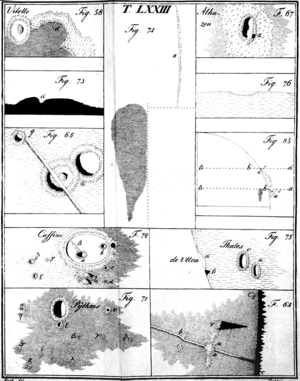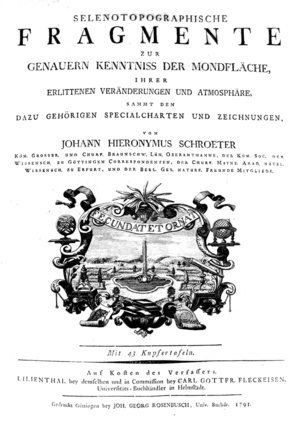Johann Hieronymus Schröter facts for kids
Johann Hieronymus Schröter (born August 30, 1745, in Erfurt; died August 29, 1816, in Lilienthal) was an important German astronomer. He spent many years carefully observing the Moon and planets. His detailed drawings and studies helped us learn more about space.
Contents
Early Life and His Passion for Space
Schröter was born in Erfurt, a city in Germany. He first studied law at Göttingen University from 1762 to 1767. After finishing his studies, he worked as a lawyer for ten years.
In 1777, he got a job in Hanover. He became the Secretary of the Royal Chamber for King George III. While working there, he met two of the brothers of William Herschel. William Herschel was a very famous astronomer who discovered the planet Uranus.
In 1779, Schröter bought his first telescope. It was about 91 centimeters (almost one meter) long. It had a lens that was 50 millimeters wide. He used this telescope to look at the Sun, the Moon, and Venus.
Becoming a Serious Astronomer
When William Herschel discovered Uranus in 1781, Schröter was very inspired. He decided to become more serious about astronomy. He left his job in Hanover and became a chief judge and district governor in Lilienthal.
In 1784, he bought an even better telescope. It was a Herschel reflector telescope. It had a focal length of 122 centimeters and an opening of 12 centimeters. This telescope cost him about 600 Euros in today's money. He quickly became known for his detailed reports in science journals.
But Schröter wanted to see even more. In 1786, he bought a much larger telescope. This one had a focal length of 214 centimeters and a 16.5-centimeter opening. It could magnify objects up to 1,200 times! He also bought a special tool called a screw-micrometer. With these new tools, he began to study Venus, Mars, Jupiter, and Saturn very carefully.
Discoveries and Important Work
Schröter made many drawings of the features he saw on Mars. However, he mistakenly thought these features were just clouds, not actual landforms.
In 1791, he published a very important book about the Moon. It was called Selenotopographische Fragmente zur genauern Kenntniss der Mondfläche. This long title means "Selenotopographical Fragments for a More Accurate Knowledge of the Moon's Surface." In this book, he created a way to measure how bright different parts of the Moon were. This scale is still sometimes used today and is named after him.
In 1793, he was the first to notice something strange about Venus. When Venus is seen as a crescent (like a sliver of the Moon), its shape often looks a bit more curved than it should. This is called the Schröter effect.
Schröter had two famous astronomers work as his assistants. They were Karl Ludwig Harding (from 1796 to 1805) and Friedrich Wilhelm Bessel (from 1806 to 1810). Both of them later became very important astronomers themselves.
Challenges and Legacy
Sadly, in 1813, Schröter faced a terrible event during the Napoleonic Wars. French soldiers, led by Vandamme, destroyed his observatory. They also ruined his books and writings. He never fully recovered from this great loss.
His detailed drawings of Mars were lost for many years. They were finally found in 1873 and published in 1881, long after he had passed away.
Schröter was recognized for his contributions to astronomy. He became a member of the Royal Swedish Academy of Sciences in 1794. In 1798, he was also elected a Fellow of the Royal Society, a very respected scientific group in England.
Today, several places in space are named after him. There is a crater on the Moon called Schröter. There is also a crater on Mars named Schroeter. And a long valley on the Moon is known as Vallis Schröteri (Schröter's Valley). These names honor his important work in astronomy.
See also
- List of largest optical telescopes in the 18th century




